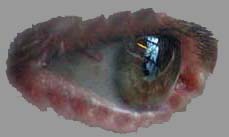

 |
|
|
Testing the Waters— Palestine & Israel, 2006 |
|
|
Journal, April 21, 2006 (edited May 4) —HaifaPhotos: Baladna Jerusalem trip Haifa journal—Part six—Baladna youth to JerusalemBy Skip Schiel A trip to Jerusalem yesterday [April 20, 2006] to meet about 5 Baladna youth groups from different parts of Israel including the Negev desert (pronounced na-kob in Arabic), the Galilee (I believe), and the Triangle area (in central Israel north of Tel Aviv). Some of the villages are Fasouta, Jdaideh, Nazareth, Kufr-Qassem, and Rahat. The trip is a part of the annual study series that Baladna organizes for youth leadership groups. These trips are aimed to be encounters for the youth, where they meet with youth from different locales (South, North, Triangle area and Center of Israel), and spend enjoyable times with each other. The study trip also helps youth learn more about the Old City from historical and architectural perspectives. A third reason for this excursion of some 30 high school age students was to explore the reality of the occupation. This is important for these particular students because being Arab in Israel they are not subject to the more obvious strictures of the hated institution such as checkpoints, the Separation Wall, closures, and roadblocks. So this trip is consciousness raising, awareness building, basic teaching of the experiences of most Palestinians in the region. Specifically, the idea was to examine the wall in Abu Dis which they did, look at Kalandia checkpoint which they didn't, and discover some of the contemporary experiences of Palestinians in the Old City, again not done. Why these omissions is a major part of the story of occupation. Because of new construction at Kalandia, finishing key sections of the Wall, the trip there and back would have been torturously long. Because of the lateness of getting to the Old City, plus the unexpected throng of tourists--reflecting both the season, Easter, and a relative easing of tensions--the leaders decided not to require the students to break off into small groups for Old City research. They were to have engaged in a sort of scavenger hunt, encouraged to ask questions of shop owners, for instance, about life in the Old City. This research was then to culminate in a discussion all together, with input from an expert. This also did not fully happen because of the lack of research. What did appear to happen was many students getting to know each other better, having fun together. For example, near the end, after the lecture about Jerusalem, at the national Palestinian Theater in East Jerusalem, most of the students formed a circle and began spontaneously playing games. Much laughter, pushing, and even pushups for the losers of each round. What also happened was much milling around waiting for other groups to reach certain locations--we might call it schmoozing. During the lecture and preceding film (about Mahmoud Darwich), kids did not seem attentive. They were restless, talked among themselves, and a few walked out. I photographed as much of this activity as I could. At first, since no one introduced me, I noticed some kids eyeing me suspiciously. But after they'd seen me chatting with Inas, the coordinator of this trip, and saw how dedicated I was to my photo pursuit, they seemed to mellow, some eventually asking me to photograph them. While in the Church of the Holy Sepulcher where Inas and I first met them, and while waiting for something to happen with the groups, I wandered about the entry area of the church, photographing pilgrims kissing the stone slab that allegedly held Christ's body when it was prepared for burial. Fat chance of this being fact, like the poor innocent rock termed Plymouth Rock, the rock on which the pilgrims stepped from the ship to the shore, but fact seems not to be the major factor in faith. A higher truth, perhaps, prevails. Fact: this man called Christ lived. Fact: he lived around here about 2000 years ago. Fact: his teachings were roughly as recounted in the gospels. Fact: the authorities executed him. And final fact: much about his story endures, the idea of resurrection for instance, perhaps, perhaps. So the idea occurred to me: come back here on my own, especially when many are present, and wander about photographing pilgrims at work. Now about from Haifa to Jerusalem and back, since this is part of the story of occupation. Inas and I used shuruts , shared taxis—total time getting to Jerusalem was a little over 3 hours for a distance of some 130 km (about 100 miles) , much of that caught in traffic or waiting for a shurut to fill (we needed 2, Haifa to Tel Aviv, Tel Aviv to Jerusalem), time back was less, less than 3 hours, cost was 88 shekels, 22 higher than the bus. The route, #4, was mostly ugly, thru industrial or strip malls. As beautiful as the land is in some parts, particularly the West Bank, much of the coast is poorly planned, one huge sprawl I'm sorry to report. LINKS Baladna work camps 2006 (scroll down to Workcamps 2006) Old city jerusalem |